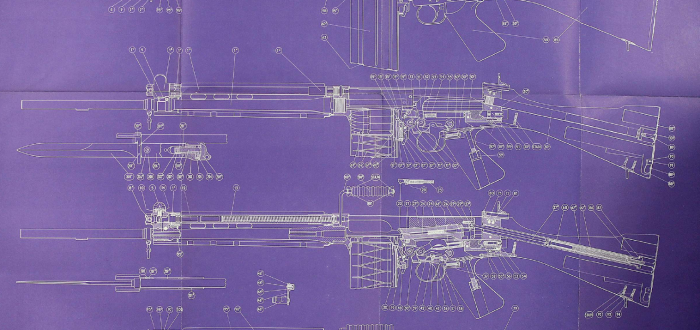Armament Research Services is proud to release the first in our Field Guide series of publications, aimed at providing researchers, investigators, and other practitioners with useful reference information on a particular topic. Field Guide No. 1 – Identifying & Tracing the FN Herstal FAL Rifle, authored by ARES Director N.R. Jenzen-Jones and Damien Spleeters of Conflict Armament Research, focuses on identifying and tracing Belgian FAL rifles, and provides key information on factory markings and physical characteristics. The guide further describes the primary variants produced by FN Herstal in Belgium, discusses FAL rifles documented in the Middle East/North Africa (MENA) region, and looks at some of the factors involved in their illicit diversion, using the ongoing conflict in Syria as a case study.
Some extracts from the full publication are given below:
The FAL rifle is an iconic product of the Cold war. Nicknamed ‘The Right Arm of the Free World,’ the weapon was designed and first manufactured at Fabrique Nationale d’Armes de Guerre Herstal , or FN Herstal (FNH), in Belgium (Stevens and Rutten, 1981). The FAL was introduced in 1953, and chambered for the new 7.62 x 51 mm NATO cartridge. The FAL is a short-stroke gas operated selective-fire rifle, utilising a tilting breechblock locking system and firing from the closed bolt. By late 1972, more than one million rifles had been produced. Dieudonné Saive’s original design underwent several changes throughout its production history, some of which can be diagnostic for identification purposes.
…
Factory markings, most commonly located on a rifle’s receiver are strong indicators of a weapon’s country of manufacture. If a positively identified manufacturer marking is consistent with the overall physical features of a weapon, the rifle may be considered tentatively identified (Jenzen-Jones, 2015).
Although factory markings, located on the right-hand side of the Belgian FAL, do not explicitly refer to the weapons’ date of manufacture, they do provide relevant information. Original research conducted in the Belgian National Archives shows that between November and December 1971, FN Herstal amended its factory marking from ‘Fabrique Nationale d’Armes de Guerre Herstal Belgique’ to ‘Fabrique Nationale Herstal Belgique’. Observing the former factory name marked on a rifle would thus indicate a date of manufacture preceding the November–December 1971 date (see Photo 2). Factory markings with the latter name, on the other hand, would indicate a manufacturing date after this change (see Photo 3) (Spleeters, 2013).
…
Photo 2: Factory marking reflecting manufacture prior to November–December 1971.
Marked: ‘FABRIQUE NATIONALE D’ARMES DE GUERRE–HERSTAL–BELGIQUE’
Photo 3: Factory marking reflecting manufacture after November–December 1971.
Marked: ‘FABRIQUE NATIONALE HERSTAL BELGIQUE’…
A careful examination of the features of the rifles used by rebel fighters in Syria indicate, with some degree of certainty, that those weapons have been diverted from, or by, their original and legitimate end user. Given Syria’s purchase of FAL rifles before 1969, rifles which formed a part of the Syrian government’s stockpile prior to the war should be recognisable by either a Type I or Type II receiver. The presence of rifles with Type III receivers … tends to support the hypothesis that at least some of these rifles documented in Syria have been diverted from their original, licensed end user.
To read the full publication, click here.
Field Guide No. 1 is supported by Research Note No. 9 – Estimating Year of Production for FAL Rifles, released earlier this week, and the accompanying FAL Year of Production Estimator tool, which calculates the likely year of production for a given FN Herstal FAL serial number. The tool also gives an interpolated estimate of the month of production with error bounds.
For more publications from ARES, see our Publications page.
Header image extracted from original FN Herstal manual issued by the Peruvian armed forces (printed in Belgium). Other images copyright Damien Spleeters.

